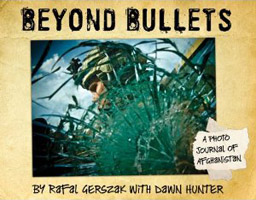| ________________
CM . . .
. Volume XVIII Number 9. . . .October 28, 2011 
 |
Beyond Bullets: A Photo Journal of Afghanistan.
Rafal Gerszak with Dawn Hunter.
Toronto, ON: Annick Press, 2011.
128 pp., hardcover, $19.95
ISBN 978-1-55451-293-5.
Subject Headings:
Afghanistan-Juvenile literature.
Afghanistan-Social conditions-Juvenile literature.
Afghanistan-Pictorial works-Juvenile literature.
Grades 7-10 / Ages 12-15.
Review by Val Ken Lem.
*** /4
|
| |
|

excerpt:
Today I was struck again by how reminders of war—past and present—are everywhere in Afghanistan. Inside the old blown-out, abandoned Russian building in this picture, the Afghans have set up rooms with punching bags, wrestling mats, and the like. It's barely lit, and on the crumbling walls are painted symbols depicting mines and rockets. I can't help but think of home, where I walk on the streets and see murals of trains or kids playing, or flowers. Here it's a whole other kind of graffiti.
Rafal Gerszak is a respected Vancouver-based photojournalist and short filmmaker. He spent a year embedded with the American coalition force in Afghanistan and then returned on his own to document the life of civilians living in a country in a state of war. He states his goals in the preliminary pages: to give a voice to the people of Afghanistan by telling some of their stories, and to allow people who view his photographs and read his text "to see and feel what it's like to live every day with the war on your doorstep."
Part I, consisting of about one-third of the book, focuses upon Gerszak's life and work amongst the American forces. Short entries explain a situation that is illustrated by one or occasionally a couple of photographs. The text is written like an undated diary entry and set in an appropriate font that mimics hand printing. Gerszak's storytelling skills are a complement to the photos as he describes settings in vivid language. Readers will feel the stifling heat and discomfort riding in the back of a Humvee, or share despair as medical staff and an Afghan father are all unable to prevent the death of a young girl. At all times, one is on guard as evidenced by a humanitarian aid drop where Gerszak captures the smiles on the faces of young boys and yet 15 minutes later is under artillery attack as the soldiers head back to base. The text and photos tell about the local Afghan police as well as local customs and military operations. Informative sidebars provide additional context to the wars in Afghanistan, such as the rise of the Taliban, the NATO forces and the roles of Afghan soldiers and private security firms. Other sidebars help to demystify some of the practices and beliefs of Muslims, including the differences in interpretation that play out in this land. It is likely that these sidebars are the work of Gerszak's collaborator, Dawn Hunter, but it is unclear as to the extent of her role in helping to shape the rest of the text.
After seeing the military side of life in Afghanistan, Gerszak returned to Kabul Province to record the lives of civilians. In Part II, he visits a lakeshore retreat, a golf course without grass, a men and boys only swimming pool, and a dogfight where people can relax and grab a moment of life without the worry of war. The very rare pig that inhabits the Kabul zoo is a surprising hit since pork is forbidden and there are no other opportunities to see a live pig in the country. Gerszak is also able to visit farmers harvesting wheat and cherries, and he records the excitement of political campaigns. Other tours are more haunting, including those to refugee camps in Kabul Province, a mental health center, and a prison where he was able to meet some Taliban insurgents. There is limited coverage of the everyday existence of women, but a small number did allow their photographs to be taken and their stories told.
The volume includes several full-colour maps that show Afghanistan in the world, the provinces of Afghanistan, and the areas of the provinces where his photographs and stories take place. All together, Beyond Bullets is a valuable photo journal that is especially successful at showing how people in a country carry on living in the midst of a war-torn land.
Recommended.
Val Ken Lem is a librarian at Ryerson University in Toronto, ON.

To comment
on this title or this review, send mail to cm@umanitoba.ca.
Copyright © the Manitoba Library Association. Reproduction for personal
use is permitted only if this copyright notice is maintained. Any
other reproduction is prohibited without permission.
NEXT REVIEW |
TABLE OF CONTENTS FOR THIS ISSUE
- October 28, 2011.
AUTHORS |
TITLES |
MEDIA REVIEWS |
PROFILES |
BACK ISSUES |
SEARCH |
CMARCHIVE |
HOME |
